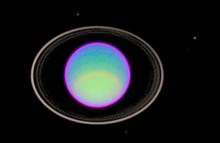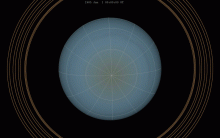Listen to today's episode of StarDate on the web the same day it airs in high-quality streaming audio without any extra ads or announcements. Choose a $8 one-month pass, or listen every day for a year for just $30.
You are here
Venus and Uranus
The insides of the planet Uranus are weird. Some models of the planet suggest it could have “diamondbergs” floating in an ocean of metallic liquid carbon.
Uranus is the seventh of the Sun’s major planets. And it may be the solar system’s weirdest planet, period. It’s the third-largest planet, but only the fourth most massive.
That’s one indication that most of Uranus consists of hot “ices” — water, methane, and ammonia. They’re heated by the great pressure in the mantle — the layer below the planet’s atmosphere.
There are several ideas about what’s happening in that layer. The most popular says that high temperatures in the mantle cause the methane to separate into its individual molecules. The carbon forms diamonds. They rain through the mantle, settling in an ocean around the core. The carbon is squeezed so tightly that it forms a metal. Electric currents in the ocean then generate the planet’s magnetic field.
It’s hard to know what’s happening, though, because only one spacecraft has visited Uranus — four decades ago. There are plans for a new mission, but it won’t get there for a long time — providing a better look deep into this weird planet.
Uranus stands close to Venus, the “evening star,” the next couple of nights. Uranus is easily visible through binoculars. It looks like a faint green star. It’s to the upper left of Venus this evening. It’ll be about the same distance to the lower left of Venus tomorrow night.
Script by Damond Benningfield





